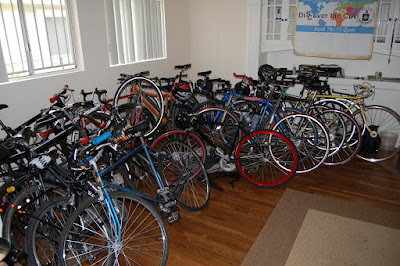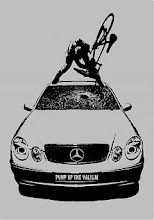The race begins at the summit of Falls Creek descending to Mt Beauty. From there is the first big climb of the day up and over Tawonga Gap. The ride then travels through Harrietville followed by the biggest climb of the day up Mt Hotham. It then descends in to Omeo, followed by the final climb back to the summit of Falls Creek - 230kms (143 miles) and approximately 14,000 feet (4,500 meters) of climbing later. 1250 riders were registered to participate. For folks in the U.S., this ride is similar to the Death Ride in California It's been billed as the hardest ride in Australia, and comparable to the toughest stages of the Tour de France, fun times ahead.
.jpg)

> The course profile and map
Friday 5th: I drove up to the town of Merton with my Mum to stay at my Auntie and Uncles farm. Heavy rains were pushing through, a bad sign for the weekend

> My Aunt and Uncle's rescued featherless Cockatoo
Saturday 6th: Set out early from Merton, stopping off briefly in Benalla and Bright for a coffee. We arrived at the Falls Creek village early afternoon, after passing over the Tawonga Gap. The weather was sunny and warm, but it was unlikely it would last.

> Looking from the top of Tawonga Gap over the town of Mt. Beauty, out towards Falls Creek where the ride begins

> The welcome sign at the base of Falls Creek
Saturday night we had free accommodation at the Carey Ski Lodge thanks to Mum offering to volunteer on the course, her first time volunteering in a ride like this. The lodge is located in Falls Creek village - Falls Creek being one of the best locations for skiing in Victoria, at least in the winter. After registering for the ride and volunteering, a pre-ride debriefing, some last minute bike-prep and repairs, and a pasta dinner in the events arena, it was an early night.

> Carey Ski Lodge at the top of Falls Creek village

> The pasta dinner in the events village
Unfortunately I was awoken to the sound of some fairly severe sounding storms - torrential rain, hail, wind, combined with lightning and thunder. The luxury of sleeping in a real bed rather than a tent the night before a ride was interrupted by vivid dreams of riding in violent electrical storms.
Sunday 5am: Wake up, walk to registration to leave my 'drop bag' of dry clothes to be collected at the lunch break, half way in to the ride at kilometer 115 in Dinner Plain, just after summitting Mt. Hotham...little did I know the importance of this clothing. Breakfast, change in to ride gear, and roll out to the start line. It's stopped raining, but the road is wet and the temperature is cold, though not freezing. Long sleeve gloves and a rain jacket still seem a good idea.
7.30am - the ride starts. There are three ride options - the full 230km starting from Falls Creek, a 115km option starting either at Falls or from half-way at Dinner Plain, or a team relay effort. Everyone rolls out gingerly, cold and aware of the wet conditions. Within 2km I've seen several riders with flats or who have maybe crashed, many more follow down the hill. The descent is slow, avoiding the slick conditions and the many 100s of riders over the next 30km. Towards the bottom riders start to pull over - time to lose the gloves and jacket before the first big climb of the day up and over Tawonga Gap, about 7km long.
The first climb seems to present no problems. I'm sucking up many of the riders that I had let get ahead due to my lack of experience descending in the wet, thanks to living in the eternal summer that is Los Angeles. Some riders are blazing past me, but I resist the urge to jump on their wheel - need to save energy for the rest of the day. Towards the top of the climb is the first aid station, time to stock up on some food and gels. However the cloud and fog has rolled in, and visibility has dropped to maybe 50 feet. The descent down from Tawonga Gap is faster, the riders have spread out and the road has dried a little. A false sense of hope is quickly crushed as the weather closes in - more fog and now some rain. Just a few drops, no need for the jacket. Hrmm more rain, better put on the jacket...
9.30am - After going out on my own I get caught up by a pack of maybe 10 riders. I jump in to save some energy on the rollers in to Harrietville. As we pull in to the aid station I realize I'm soaked to the bone, and I can't see through my sunglasses due to rain, and well, lack of sunshine. I'll have to ride half-blind as my sunglasses are prescription, and my glasses are elsewhere. "Keep moving, dont stay at the aid station too long, need to stay warm" - I tell myself this as I roll out for the beginning of the biggest climb of the day - 35km/22 miles of climbing, some sections getting up to 11% gradient.

> The ascent up Mt Hotham from Harrietville
I get in to a pretty good rhythm, ignoring the driving rain and cold, laughing that someone has spraypainted on the road of the "MEG" climb (a section of 9% gradient road) "Meager X X" (I forget the rest of the acronym but you get the idea). Another aid station stop, grab some gel and choke it down, keep riding. Towards the top of the climb I hit "The Blowhard." Thankfully the wind doesn't do justice to the name today, but as I literally see my computer tick over 100km, a loud clap of thunder rumbles across the sky. Soon after the cloud closes in and the wind picks up - I am above the tree line now, and things are getting worse. Visibility drops to almost zero. I can't see the road. A false summit appears as the cloud clears, "I'm almost there! Wait, what's that?" Turns out there is a last 2.5km, 9% gradient climb to the real summit, and I can see a trail of cyclists like little ants, head down, riding in to the storm. Damn.
The wind picks up some more, and I realize I'm getting cold. 1km of climbing to go. the wind is so hard I'm standing up on the bike, forcing the cranks to turn over - I look down to my computer - 4km an hour. I might as well just walk.
Over the top! I've done it, I've summitted Mt. Hotham, one of the toughest climbs in Australia, I feel good, and I'm ahead of my estimated time with a 24km/h average. But the real misery is about to set in - the descent brings bone chilling cold. It's 6 degrees C/42F at the peak but I'm soaked to the bone and the wind is ripping through me, it feels closer to freezing. Inside a tunnel at the entrance to Hotham village a bunch of us stop, desperately clamber to get some food in our mouths, realizing our fingers and other extremities no longer are functioning correctly. Keep moving. More descending to Dinner Plain, I'm now almost in tears. I can't stand it, I can't feel my hands, can barely control the bike, and others are crashing as they struggle to steer. "When will the lunch stop appear, they said 115km and I'm at 120km, fuck. I just want my warm clothes and a coffee, damn I hope they have coffee there..." It's been raining for almost 5 hours straight now, I hate this. Misery envelops me, I start begging for some climbing to at least warm me up a bit, and without realizing I'm abusing another cyclist for throwing a wrapper of his energy bar on the ground. Fuck him. Fuck life.
12.30pm - Finally! Pull in to Dinner Plain - the half-way mark, lunch, and where my dry clothes are awaiting me. I dump my bike and gingerly clamber in to the small building where the drop bags are. About 50 other frozen cyclists are desperately trying to get their bag, find a place to change, and regain some feeling in their limbs so they can get their wet gear off. I take what seems like forever to get changed. Warm, dry cycling gear, including my thermal top, so glad I packed it! Dry socks, even better! I slide my feet back in to my only pair of cycling shoes, but they are so wet my dry socks last for about 3 seconds. Oh well, I can handle the numb toes. My rain jacket is still too wet and cold to put back on, but maybe that's ok...wrong. I walk outside to find its gotten colder and that my warm dry clothes are useless, its still raining and I'm wet again. Worst of all the uncontrollable body shaking I experienced on the descent to Dinner Plain has returned.
I run over to the restaurant that is open, and find 200 other grown women and men shivering like small children. Some had clearly neglected to leave a drop bag of dry gear, so they are trying to dry off their only clothing to little avail. At least its warm inside. Order a bowl of fries to warm up, along with every other cyclist - it's not part of the provided lunch, but who cares - a true privilege on such a ride. Riders are scrambling to find any extra layers to wear - plastic bags as extra layers are the clothing of choice. I speak to one guy who's decided to continue - "I've got six layers on. My girlfriend is at Omeo, I'll have to make it at least to there to ensure I can get home." Good luck.
Ok, time to leave the restaurant and ride. As I set out to find the bike I hear an announcement from the course officials "There is a severe storm warning. Hail is predicted. If you are not prepared don't continue - the 40km descent will be cold, and if you can't make it to the next aid station it may be several hours before the SAG wagon picks you up." I'd heard earlier that Melbourne had experienced the worst hail storm in years, hail the size of golf balls that was smashing car windows. Hrmmm.

> My Dad's car windshield after the hail storm hit Melbourne. Best not to take one of those to the head.
I'm still too cold to go on. Rumor has it that they officials have organized buses to pick up riders who can't continue. The rumors are true, and riders begin to pile on to the bus to get back to Falls Creek. I decide that I cant do it - I have no one to ride with, and my gear is wet again, my body is still shaking. I can't believe after all this I'm giving up, but the 100s of other cyclists doing the same makes me feel not so bad.
The ride is over, and now the ride of shame on the bus begins. A slow 2 hour ride down Hotham, retracing the course back to Falls Creek.
3 Peaks Challenge 2010 DVD from Ben Miller on Vimeo.
Thanks to all the volunteers and organizers that made the ride possible, my Mum for volunteering, support, and mum-like advice, and Selfy for the loan of the Ken Evans roadbike that got me through as far as I did, along with the other 1000 or so km's of training.












